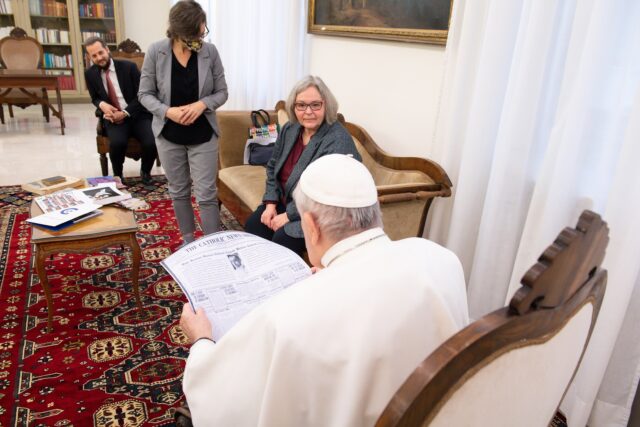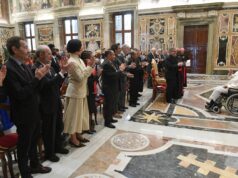
VATICAN CITY — When Pope Francis met members and staff of the Dicastery for Communication Nov. 12, he said listening to people is at the heart of communication and must be a special mark of Catholic communication efforts.
And then he pointed to Andrea Monda, director of the Vatican newspaper, L’Osservatore Romano, who, the pope said, listens and takes risks.
However, referring to the cost of running the paper, Pope Francis also said, “Yes, L’Osservatore is a problem, we all know that” but Monda, “instead of closing L’Osservatore opens another, the ‘street’ edition!”
L’Osservatore di Strada, a monthly, is funded by donors and includes articles, commentary, photos, poetry and drawings from people who are poor or homeless. The homeless distribute the newspaper for a freewill offering every Sunday to people attending the pope’s Angelus prayer in St. Peter’s Square, keeping what they earn.
“If L’Osservatore Romano and the other Vatican media are called to offer readers a key for interpreting this pontificate and this age, a reality like L’Osservatore di Strada tells them what kind of time we are living in and what is the vision of Pope Francis,” Monda said. “It explains it much better than a treatise would.”
As for the main newspaper, without offering statistics or budget figures, Monda acknowledged that subscriptions to the print edition continue to decline, so they have been cutting costs while also building up their online edition “with great results. Today we have more than 10 times the number of online readers than we did four years ago,” and that is even after starting to charge a “symbolic” 20 euros for an annual subscription two years ago and recently doubling the price.

Still, Monda is convinced that L’Osservatore “must have a print edition” and not only because it has had one for 161 years. Its role as an institutional source of information about the Vatican and, especially, about the teaching of the popes means each issue is a document.
After all, he noted, a papal decree ends with a line saying it will enter in effect upon publication in L’Osservatore Romano; “it’s an official gazette.”
Helen Osman, president of Signis, the World Catholic Association for Communication, said that while there are signs of hope for Catholic media in many parts of the world, especially in Asia, “I think, in general, we’re challenged. And one of the reasons is because we have a credibility issue with our readers, viewers, listeners.”
“I hear that everywhere. I mean, everywhere: the Pacific, Africa, Latin America, North America, Europe. There’s no exception to that at least if people are willing to look critically and objectively at their impact,” she told Catholic News Service Nov. 12 while at the Vatican for the Dicastery for Communication meeting.
Asked specifically about Catholic newspapers, Osman said, “I don’t think print is dead, but I don’t think it is king anymore.”
But even Catholic radio stations in Africa and Latin America, where Catholic newspapers were never predominant, are asking questions like those facing Catholic newspapers, she said.
Catholic radio journalists ask, “what do we want to have on our stations?” she said. “It’s not fluff pieces and it’s not pious devotions that you’re broadcasting. But how do you engage with people and issues that matter for them in their daily lives? And I can tell you, this issue of holding our own church accountable is everywhere. It is everywhere.”
Defunding newspapers and halting publication may not be the best use of resources, said Mauro Ungaro, president of the Federation of Italian Catholic Weeklies and editor of one of them, Voce Isontina, the newspaper of the Archdiocese of Gorizia.
“Diocesan newspapers are not an expense but an investment,” he said.
The federation includes 187 newspapers and news websites from 160 dioceses. Some dioceses have two member publications because they run separate newspapers for Catholics who speak Italian and those who speak German or, in Gorizia, Slovenian, he said.
The number of print publications has held steady for the past 10 years, he said, but given Italy’s decreasing family size, the number of readers is obviously declining. The combined print run of the Catholic weekly newspapers is between 600,000 and 700,000 copies each week.
Most diocesan newspapers in Italy were founded after the publication of Pope Leo XIII’s encyclical on labor, “Rerum Novarum,” Ungaro said, and grew out of a recognition that the bishop and the church needed to know how people in the diocese were living, what challenges they were facing and how the church could assist and inspire them by sharing stories of faith.
While “we are not the voice of the sacristy, but of the church,” Ungaro said, the contribution and support of the bishop is essential because he is the servant of the diocese’s unity.
Like in other countries, he said, there are bishops who say it would be better to put their limited resources into charity or evangelization or schools rather than newspapers. “But I think there is a material charity which the church exercises every day through Caritas and the parishes, and there is a cultural charity, which is to transmit values, transmit a message, and that is what diocesan newspapers do.”
Professional Catholic journalists evangelize by “recounting the stories of people who get their hands dirty helping the poor without seeking any attention,” he said. It is a more effective form of witness than “repeating 40 Bible verses” because it gives readers an example to follow.
During the height of the COVID-19 pandemic, he said, everyone knew the government and secular news sites where they could find charts counting the number of new infections, hospitalizations and deaths.
But “our websites registered a notable increase in traffic,” he said. People turned to their local diocesan newspapers to read about the local people behind those statistics, stories about the lives of the deceased and about the sacrifices of the doctors, nurses and priests caring for them.
– – –








